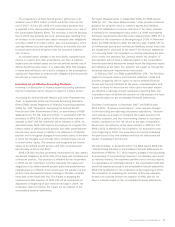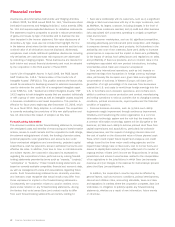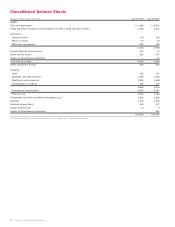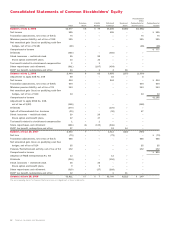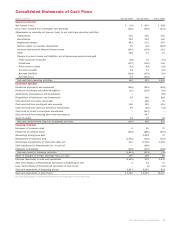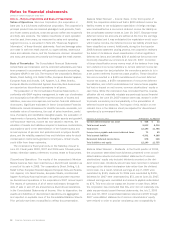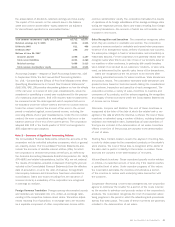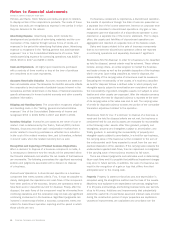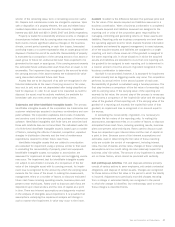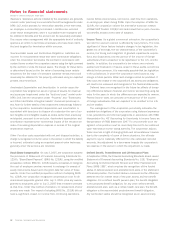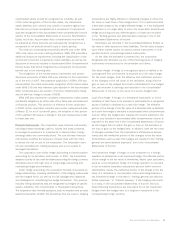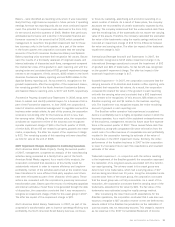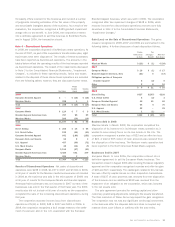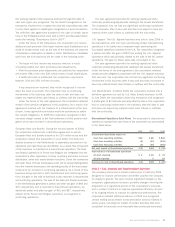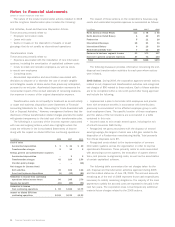Sara Lee 2008 Annual Report Download - page 48
Download and view the complete annual report
Please find page 48 of the 2008 Sara Lee annual report below. You can navigate through the pages in the report by either clicking on the pages listed below, or by using the keyword search tool below to find specific information within the annual report.Notes to financial statements
Dollars in millions except per share data
Fixtures and Racks
Store fixtures and racks are given to retailers
to display certain of the corporation’s products. The costs of these
fixtures and racks are recognized as expense in the period in which
they are delivered to the retailer.
Advertising Expense Advertising costs, which include the
development and production of advertising materials and the com-
munication of this material through various forms of media, are
expensed in the period the advertising first takes place. Advertising
expense is recognized in the “Selling, general and administrative
expenses” line in the Consolidated Statements of Income. Total
media advertising expense for continuing operations was $325 in
2008, $313 in 2007 and $298 in 2006.
Cash and Equivalents All highly liquid investments purchased
with a maturity of three months or less at the time of purchase
are considered to be cash equivalents.
Accounts Receivable Valuation Accounts receivable are stated at
their net realizable value. The allowance for doubtful accounts reflects
the corporation’s best estimate of probable losses inherent in the
receivables portfolio determined on the basis of historical experience,
specific allowances for known troubled accounts and other currently
available information.
Shipping and Handling Costs The corporation recognizes shipping
and handling costs in the “Selling, general and administrative
expenses” line of the Consolidated Statements of Income and
recognized $703 in 2008, $656 in 2007 and $619 in 2006.
Inventory Valuation Inventories are stated at the lower of cost or
market. Cost is determined by the first-in, first-out (FIFO) method.
Rebates, discounts and other cash consideration received from a
vendor related to inventory purchases is reflected as a reduction
in the cost of the related inventory item, and is therefore, reflected
in cost of sales when the related inventory item is sold.
Recognition and Reporting of Planned Business Dispositions
When a decision to dispose of a business component is made, it
is necessary to determine how the results will be presented within
the financial statements and whether the net assets of that business
are recoverable. The following summarizes the significant accounting
policies and judgments associated with a decision to dispose
of a business.
Discontinued Operations
A discontinued operation is a business
component that meets several criteria. First, it must be possible to
clearly distinguish the operations and cash flows of the component
from other portions of the business. Second, the operations need to
have been sold or classified as held for disposal. Finally, after the
disposal, the cash flows of the component must be eliminated from
continuing operations and the corporation may not have any significant
continuing involvement in the business. Significant judgments are
involved in determining whether a business component meets the
criteria for discontinued operation reporting and the period in which
these criteria are met.
If a business component is reported as a discontinued operation,
the results of operations through the date of sale are presented on
a separate line of the income statement. Interest on corporate level
debt is not allocated to discontinued operations. Any gain or loss
recognized upon the disposition of a discontinued operation is also
reported on a separate line of the income statement. Prior to dispo-
sition, the assets and liabilities of discontinued operations are
aggregated and reported on separate lines of the balance sheet.
Gains and losses related to the sale of business components
that do not meet the discontinued operation criteria are reported
in continuing operations and separately disclosed if significant.
Businesses Held for Disposal
In order for a business to be classified
as held for disposal, several criteria must be achieved. These criteria
include, among others, an active program to market the business
and locate a buyer, as well as the probable disposition of the business
within one year. Upon being classified as held for disposal, the
recoverability of the carrying value of a business must be assessed.
Evaluating the recoverability of the assets of a business classified
as held for disposal follows a defined order in which property and
intangible assets subject to amortization are considered only after
the recoverability of goodwill, intangible assets not subject to amor-
tization and other assets are assessed. After the valuation process
is completed, the held for disposal business is reported at the lower
of its carrying value or fair value less cost to sell. The carrying value
of a held for disposal business includes the portion of the cumulative
translation adjustment related to the operation.
Businesses Held for Use
If a decision to dispose of a business is
made and the held for disposal criteria are not met, the business is
considered held for use and its assets are evaluated for recoverability
in the following order: assets other than goodwill, property and
intangibles; property and intangibles subject to amortization; and
finally, goodwill. In evaluating the recoverability of property and
intangible assets subject to amortization, in a held for use business,
the carrying value of the business is first compared to the sum of
the undiscounted cash flows expected to result from the use and
eventual disposition of the operation. If the carrying value exceeds the
undiscounted expected cash flows, then an impairment is recognized
if the carrying value of the business exceeds its fair value.
There are inherent judgments and estimates used in determining
future cash flows and it is possible that additional impairment charges
may occur in future periods. In addition, the sale of a business can
result in the recognition of a gain or loss that differs from that
anticipated prior to the closing date.
Property Property is stated at historical cost and depreciation is
computed using the straight-line method over the lives of the assets.
Machinery and equipment are depreciated over periods ranging from
3 to 25 years and buildings and building improvements over periods
of up to 40 years. Additions and improvements that substantially
extend the useful life of a particular asset and interest costs incurred
during the construction period of major properties are capitalized.
Leasehold improvements are capitalized and amortized over the
46 Sara Lee Corporation and Subsidiaries



